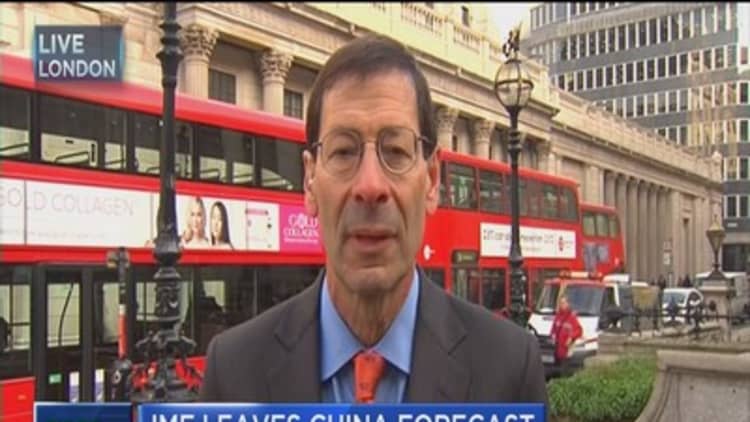Amid growing worry the U.S. economy might be on the brink of a slowdown, smaller employers are trying to stay the course.
But if you have only a handful of workers and need every hire to keep the business afloat, layoffs aren't really an option. So you tuck into survival mode and see how else you can ride out the global turmoil.
"There's a lot of fear and uncertainty with small business," said Jeff Stibel, vice chairman of Dun & Bradstreet, which along with Pepperdine University releases a quarterly reading on small- and medium-sized companies. "The noise around what's happening globally and in China is giving people enough uncertainty to create some pause," Stibel said.
For larger businesses, uncertainty can mean layoffs to immediately cut costs and boost confidence. But for smaller businesses, even micro businesses with only a few staffers running an enterprise, strategic decisions are trickier. "With small business, if you only have one or two employees, you can't lay off 50 or 100 percent of your staff," Stibel said. "You have to find some other way to survive."
Stibel added that worried business owners might start asking questions like, "Maybe I need a home equity loan?" "Maybe I have to start selling some stock?"
According to a December index reading from the National Federation of Independent Business, plans to create new jobs actually posted a 4 point gain and reflected optimism about sales. The report said job creation plans were especially strong in manufacturing, a sector that has been slowing.
Capital spending among small businesses also grew stronger in November and December, reflecting rising certainty. "The percent of owners planning capital outlays in the next three to six months rose 1 point to 26 percent, not a strong reading historically but among the best in this expansion," NFIB Chief Economist Bill Dunkelberg said in a statement.
Some Main Street hiring
The NFIB research echoes other data for the fourth quarter of 2015 that showed modest plans for Main Street job creation. About 16 percent of businesses with three to five workers said they plan to hire in the next six months — up from 14 percent for the period in 2014, according to Dun & Bradstreet's small business trends report.
Roughly 35 percent of businesses with one or two workers said they plan to hire in the next six months — slightly higher than 33 percent for the same period in 2014, according to Dun & Bradstreet.
Read MoreSome good news from the little guys: Main Street plans to hire
But even for small to mid-sized companies, market turbulence can be tough to ignore.
Global stock markets have swung wildly in the new year as crude oil prices have collapsed under $30 a barrel. China's economy also is slowing. On Tuesday, China reported its economic growth rate slowed to a 25-year low in 2015.
Also Tuesday, the International Monetary Fund reduced its global economic growth forecast for 2016. The IMF cited slower growth in emerging markets, especially in China, falling commodity prices, and rising interest rates in the U.S. as potential slowdowns to global growth.

"While it is easy to blame the 2008–2009 financial crisis for all the current economic woes, global growth has actually been on a downward trend since 2000," said Nariman Behravesh, IHS chief economist.
The question on a lot of minds including investors and small business owners is whether China and the turmoil are signs of a broader economic slowdown. "There's skepticism and fear, and if this goes on long enough, you get panic," Dun & Bradstreet's Stibel said.
A case for 'Made in USA'
If any small business is not tied to the health of China — the world's second largest economy — it may be small U.S. manufacturers that have hinged their business model on "Made in USA" production.
For example, Barn Light Electric is a small U.S. lighting manufacturer. Nearly all of its manufacturing is based in Titusville, Florida, with some production in Melbourne, Australia. It has no operations in Asia, including China, where wages overall remain relatively cheap.
Describing businesses like Barn Light Electric as part of a manufacturing renaissance is a stretch. But for a pocket of companies, anchoring a supply chain on U.S. soil has meant savings on shipping costs and other overseas hassles. Design changes to Barn Light Electric's warehouse-style lighting can be pivoted quickly without waiting for an overseas manufacturer to respond.
And despite China's turmoil, Barn Light Electric this month just hired a new executive to expand its commercial lighting business. As China's economy continues to shift away from cheap exports in favor of the service sector and high-tech manufacturing, betting on domestic manufacturing seems prescient for some U.S. companies.
"We structured a long time ago to stay American made," said Bryan Scott, co-owner of Barn Light Electric. "I don't think I'd sleep at night if we based all our manufacturing in China right now."
Read MoreStates ringing in the new year with higher minimum wages


